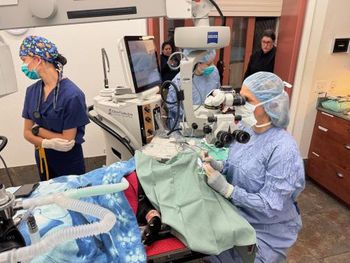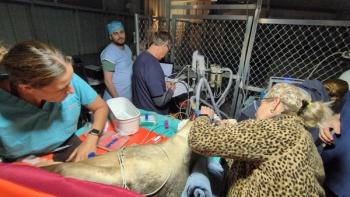
Current approaches to uveitis in the dog and cat (Proceedings)
Uveitis is inflammation of part or all of the uvea; the uveal tract is composed of the iris, the ciliary body and the choroid.
Uveitis is inflammation of part or all of the uvea; the uveal tract is composed of the iris, the ciliary body and the choroid. More descriptively uveitis may be divided into subcategories of:
1. anterior uveitis – iris and ciliary body involvement
2. posterior uveitis – choroid involvement
3. endophthalmitis – inflammation of the inside of the eye and adjacent tissue
4. panophthalmitis – inflammation of intra- and extraocular tissues
Diagnosis is made based on clinical signs as well as decreased tonometry values. Pain and decreased vision are signs the owner may note at home. Characteristic clinical findings may include blepharospasm, increased tearing, conjunctival hyperemia, corneal edema (corneal vascularization may also be present), aqueous flare and cell, miosis, iris hyperemia and swelling, vitritis, and retinal detachment. Hyphema may also be a component. Decreased tear production, anterior chamber fibrin, hypopyon, keratic precipitates, corneal ulcers, and optic neuritis may also occur. Other sequelae include glaucoma, cataract formation, lens luxation, endophthalmitis/panophthalmitis, iris bombe, and phthisis bulbi.
An etiologic diagnosis may be difficult to obtain. A retrospective study performed at North Carolina State School of Veterinary Medicine (Massa et.al. 2002) revealed that a definitive diagnosis was not possible in 47% of cases of anterior uveitis. 18% of cases were diagnosed with infectious disease. Another 25% had neoplasia leading to uveitis and 10% had uveodermatologic syndrome or vaccine reaction. In broad terms, the cause of uveitis may be categorized into infectious, metabolic, immune-mediated, neoplastic and traumatic. Diseases suspected or proved to cause uveitis in the dog:
1. algal (Prototheca sp.)
2. bacterial (Brucella canis, Borrelia burgdorferi, Leptospira sp., septicemia of any cause)
3. fungal (Aspergillus fumigatus, Blastomyces dermatitidis, Candida albicans, Coccidioides immitus, Cryptococcus neoformans, Histoplasma capsulatum)
4. immune-mediated (cataracts – lens induced uveitis, immune-mediated thrombocytopenia, immune-mediated vasculitis, lens trauma, uveodermatologic syndrome)
5. metabolic (diabetes mellitus, hyperlipidemia, systemic hypertension)
6. miscellaneous( coagulopathies, deep necrotizing or non-necrotizing scleritis, drug-induced, especially miotic agents, idiopathic, idiopathic uveitis and exudative retinal detachment, pigmentary uveitis in the Golden retriever, radiation therapy, trauma, toxemia of many causes, ulcerative keratitis)
7. miscellaneous parasitic (ophthalmomyiasis interna posterior, ocular filariasis, ocular larval migrans)
8. neoplastic and paraneoplastic disorders (histiocytic proliferative disease, hyperviscosity syndrome, granulomatous meningoencephalitis, primary and secondary neoplasms)
9. protozoan (Leishmania infantum, Toxoplasma gondii, Neopsora caninum, Trypanosoma evansi)
10. rickettsial (Ehrlichia canis or platys, Rickettsia rickettsii)
11. viral (adenovirus infection, herpesvirus). Collins and Moore in Gelatt, ed. Veterinary ophthalmology, 3rd ed. 1999.
Appropriate diagnostics include STT, fluroscein staining, tonometry, CBC, chemistry, and urinalysis. Additional bloodwork may include tick serology and fungal serology in dogs and viral testing and fungal serology in cats. PCR tests are also now available for many of the etiologic agents implicated in uveitis. Other titers may be necessary based on clinical findings and response to treatment. In many cases a blood pressure and a culture and sensitivity, if a corneal ulcer is present, would also be recommended. If the posterior segment cannot be visualized ocular ultrasound is indicated.
If all test results are negative infectious disease titers on aqueous humor, a vitreocentesis or a subretinal aspirate may be evaluated. Lastly, a blind eye may be enucleated and submitted for histopathology to obtain a definitive diagnosis.
Treatment consists of topical and oral anti-inflammatories, immunosuppressive medications and antibiotics. Subconjunctival injections of anti-inflammatories may also be used to augment topical and oral medication. Frequently used topical agents are 1% prednisolone acetate and 0.03% flurbiprofen q 4-6 hr. Oral non-steroidal anti-inflammatories and oral prednisone at anti-inflammatory doses (.25 mg/lb) are also indicated. Some dogs may need immunosuppressives such as azathioprine to control immune-mediated uveitis. Anti-inflammatories may need to be used in the face of sever infection because the associated inflammation may cause drastic irreparable consequences to the eye and vision. The use of anti-inflammatories with active infection needs to be discussed with the owner prior to use and written authorization from the owner may be advisable.
Doxycycline at 5 mg/kg is a good antibiotic with which to begin treatment. Diagnostic results should guide further antibiotic use for both specific medication and duration of treatment. Itraconazole at the label dosage is recommended on a long term basis for fungal infection; many patients stay on it lifelong with intermittent evaluation of a CBC and chemistry.
Immune-mediated uveitides often also require longterm treatment with low level anti-inflammatories. It is not uncommon to have a patient on prednisone at once or twice weekly for years. Adjunctive use of cycloplegic mydriatics such as atropine or tropicamide is warranted to stabilize the blood:ocular barrier and to control pain. Use of these two medications should be monitored closely as secondary glaucoma is often associated with uveitis; further compromising an already abnormal iridocorneal angle may be detrimental to the patient. I generally feel that atropine may be used a little more aggressively in cats but pressures should be closely monitored as the duration of action of atropine is so long. Tropicamide with its shorter duration of action may be a better choice overall.
In summary, treatment and control of uveitis may be challenging due to the often undiagnosed etiology and the fast development of irreversible sequelae. Aggressive treatment based on presentation is required.
Newsletter
From exam room tips to practice management insights, get trusted veterinary news delivered straight to your inbox—subscribe to dvm360.




